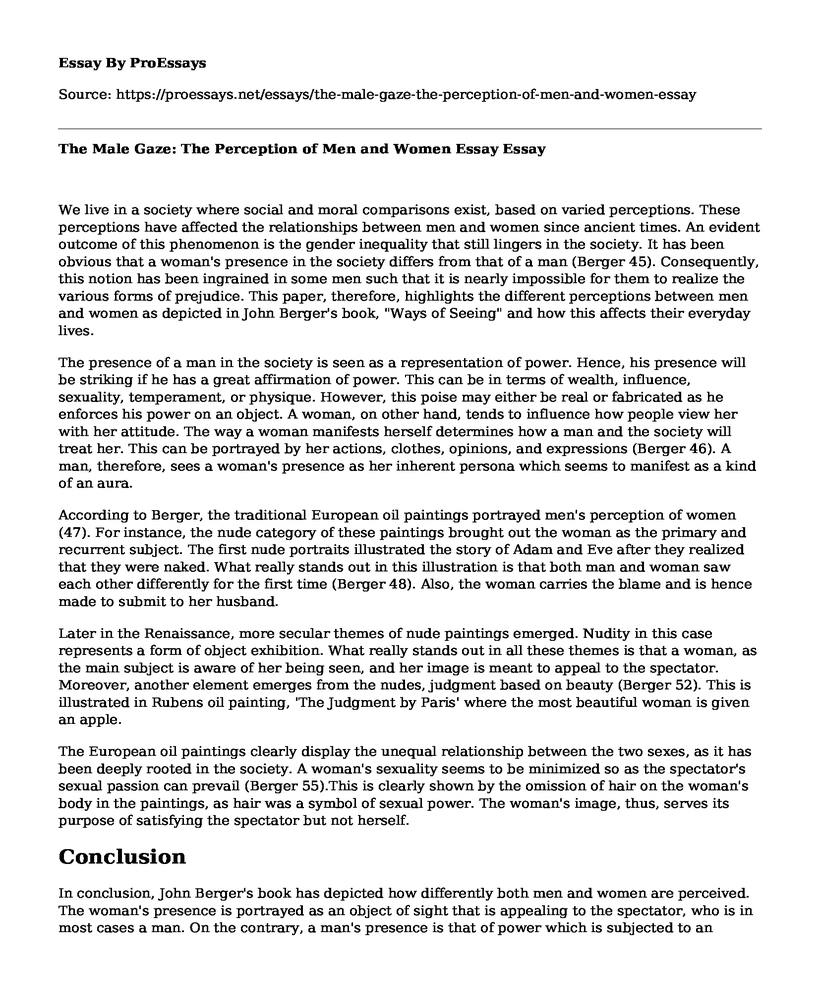We live in a society where social and moral comparisons exist, based on varied perceptions. These perceptions have affected the relationships between men and women since ancient times. An evident outcome of this phenomenon is the gender inequality that still lingers in the society. It has been obvious that a woman's presence in the society differs from that of a man (Berger 45). Consequently, this notion has been ingrained in some men such that it is nearly impossible for them to realize the various forms of prejudice. This paper, therefore, highlights the different perceptions between men and women as depicted in John Berger's book, "Ways of Seeing" and how this affects their everyday lives.
The presence of a man in the society is seen as a representation of power. Hence, his presence will be striking if he has a great affirmation of power. This can be in terms of wealth, influence, sexuality, temperament, or physique. However, this poise may either be real or fabricated as he enforces his power on an object. A woman, on other hand, tends to influence how people view her with her attitude. The way a woman manifests herself determines how a man and the society will treat her. This can be portrayed by her actions, clothes, opinions, and expressions (Berger 46). A man, therefore, sees a woman's presence as her inherent persona which seems to manifest as a kind of an aura.
According to Berger, the traditional European oil paintings portrayed men's perception of women (47). For instance, the nude category of these paintings brought out the woman as the primary and recurrent subject. The first nude portraits illustrated the story of Adam and Eve after they realized that they were naked. What really stands out in this illustration is that both man and woman saw each other differently for the first time (Berger 48). Also, the woman carries the blame and is hence made to submit to her husband.
Later in the Renaissance, more secular themes of nude paintings emerged. Nudity in this case represents a form of object exhibition. What really stands out in all these themes is that a woman, as the main subject is aware of her being seen, and her image is meant to appeal to the spectator. Moreover, another element emerges from the nudes, judgment based on beauty (Berger 52). This is illustrated in Rubens oil painting, 'The Judgment by Paris' where the most beautiful woman is given an apple.
The European oil paintings clearly display the unequal relationship between the two sexes, as it has been deeply rooted in the society. A woman's sexuality seems to be minimized so as the spectator's sexual passion can prevail (Berger 55).This is clearly shown by the omission of hair on the woman's body in the paintings, as hair was a symbol of sexual power. The woman's image, thus, serves its purpose of satisfying the spectator but not herself.
Conclusion
In conclusion, John Berger's book has depicted how differently both men and women are perceived. The woman's presence is portrayed as an object of sight that is appealing to the spectator, who is in most cases a man. On the contrary, a man's presence is that of power which is subjected to an inferior object. It is, therefore, clear that these perceptions have led to an unequal relationship between the two sexes which is still expressed in the society to date.
Work cited
Berger, John. Ways of Seeing. Penguin UK, 2008.
Cite this page
The Male Gaze: The Perception of Men and Women Essay. (2022, Aug 15). Retrieved from https://proessays.net/essays/the-male-gaze-the-perception-of-men-and-women-essay
If you are the original author of this essay and no longer wish to have it published on the ProEssays website, please click below to request its removal:
- Essay Sample on The Process of Voir Dire
- Speaking Situations Essay Example
- Exercise Benefits for Youth and Elderly: Training Guide and Physiological Adaptations - Essay Sample
- Gender, Violence, & Subjectivity: Exploring the Interlocking Dynamics - Essay Sample
- Latino Presence in the US: History, Socialization, and Representation - Essay Sample
- Paper Example on Gender & Sexuality: Cultural & Biological Differences
- Paper on Culture, Ethnicity, and Judith Butler: A Reflection







